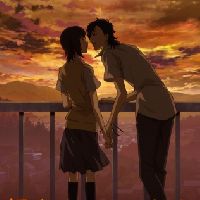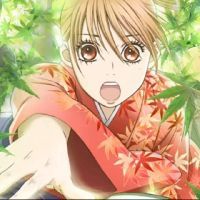
Introduction
Meet Futaba Yoshioka, a first year high school student armed with messy bed-hair and an appetite almost as large as a boy her age. She actively avoids trying to look pretty and getting attention from boys, unlike most girls. Although naturally cute, the reason Futaba strives to deflect attention is because she was once ostracized by her female classmates in middle school. They found the shy and innocent way she behaved around boys and the attention she got from them annoying and fake. Unwilling to face a friendless high school life, she changes herself to prevent history from repeating.

One day, she notices someone at school who looks a lot like Kou Tanaka, her first love in her first year of middle school and the same boy who stood her up at the summer festival and disappeared entirely after summer break without a word. The short, gentle and soft spoken boy she once knew has grown taller, became colder and pessimistic, and has a different family name. As she tries to get to know the new Kou and discover what happened to him in middle school, she learns to drop her adopted personality, speak up against the sort of girls that ostracized her in middle school, and gains some new friends along the way.
Background
Ao Haru Ride, by popular shoujo manga author Io Sakisaka, was serialized in Bessatsu Margaret from the beginning of 2011 until it's final chapter in early 2015. Its popularity saw the release of a light novel counterpart that is still in serialization, a 12 episode anime adaptation in 2014, an OVA, and a live-action movie adaptation in 2014 starring some of Japan's hottest rising young actors and actresses.

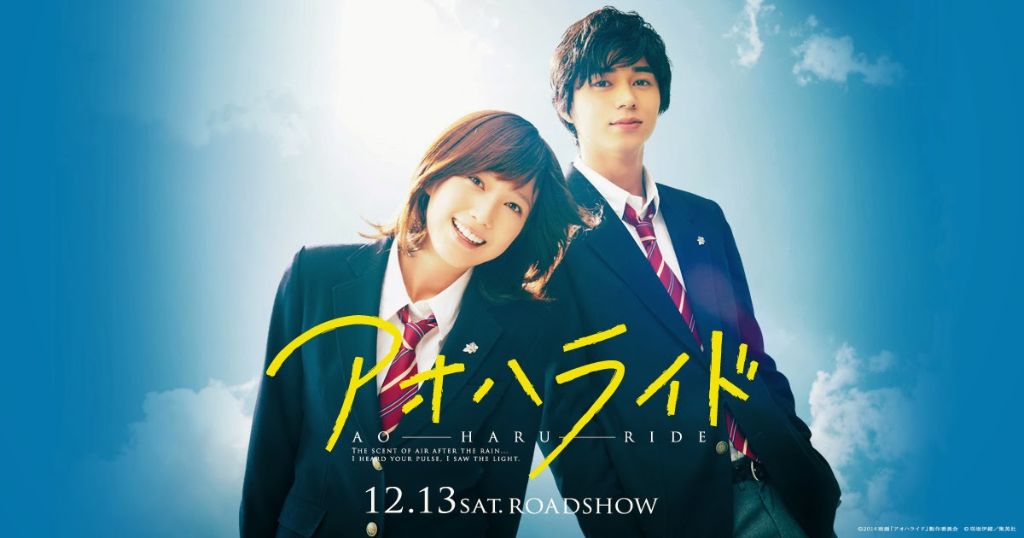
The comics have exceeded sales of 5.84 million copies, ranking highly in the oricon charts, and have been published in several languages including French, German, and Chinese.
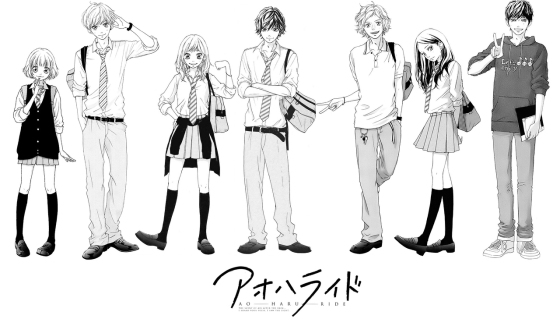
The name of the title originates from the words "ao haru" meaning "blue spring," a quasi-synonym for the Japanese word "seishun" which uses the same kanji characters for "ao haru". It can be translated to mean "the springtime of (one's) life" (i.e youth, adolescence). "Raido" or ride, as you already know, derives from that exact English word. Putting the two together, the meaning of the title goes something along the lines of "riding one's springtime of life/youth." Thus, Ao Haru Ride is about the journey of the title's adolescent characters through their most turbulent and developmental years as they face internal struggles, discover themselves, and fall in love. To further convey this message, the fictional station the main characters use everyday to get to school is called Aoharaido (青原井戸) station, a play on the title.
Appeal
Aimed primarily at an audience of teen girls, manga in the shoujo genre have appeal by embodying the sentiments, feelings and ideals of high school students and the sort of things (e.g. romance, first loves etc.) they are either experiencing, or wish to experience. They are able to experience love and heartache vicariously through the characters, see these characters as friends that they are rooting for, or simply appreciate it as a work of fiction with an enjoyable story. Those outside of this demographic would enjoy shoujo titles like Ao Haru Ride as well, especially for those who are tired of the violence and fan-service that often dominates the shounen genre. This is a shorter slice-of-life romance series with a hint of comedy, and a storyline and characters that are easy to like and not too over the top.

Ao Haru Ride is worthy of your attention for many reasons. Firstly, the series does well to capture feelings of nostalgia through its flashbacks, and the sentiments felt in the midst of a crush or romance. The structure of the series - regular Girl falls in love with handsome, popular Boy who will not admit he likes her - is very similar to most other titles in the same category. But, the author tells it in a way that is much more realistic. Ao Haru Ride does have its fair share of clichés, but in most cases, it also goes beyond them. Kou does not suddenly fall in love with Futaba one day for no reason. Futaba does not get a make-over and suddenly becomes this cute girl. Futaba is not a wallflower. The characters in this series learn from each other and the experiences they go through, growing along the way.

Moreover, the themes that can be seen in the series are realistic and connect with the sort of things that young people in real life struggle with as well. For example, loss, grief, friendship and change. Kou is riddled with guilt after the death of his mother, wishing he could have done more to make her life easier instead of spending all his time studying. The way he copes with his grief is destructive, influencing the way he treats the people close to him. But, he is able to deal with these issues through the help of his friends. Similarly, the way each person handles grief in real life is different, and like Kou the support of the people around us is vital to manage it.
Analysis
Another great thing about a lot of these slice-of-life series, whether shoujo or shounen, is that despite being fictional, you can learn quite a few things about Japan, its culture, and its society from viewing it.
1. Bullying
Bullying and suicide continue to be issues in Japan and Japanese schools. Although they weren't explicitly bullied, the sort of ostracism that both Futaba and Yuuri faced at one time embodied the passive-aggressive nature of bullying in Japanese society.
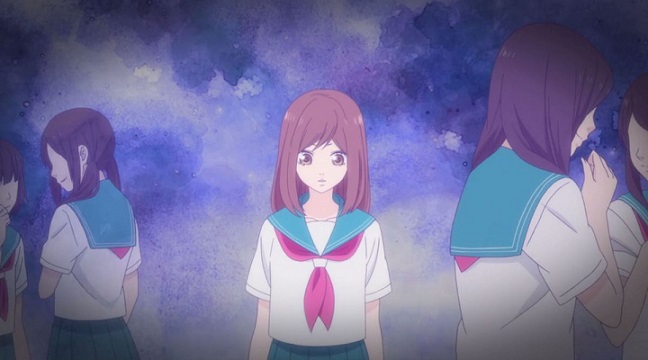
2. Conformity vs Individuality
This connects to the point above - the importance of conforming, being part of a group and meeting that group's expectations, versus being yourself, especially if it is different from the majority. Japan is known as a rather conformist society, versus the West which prides individuality and accepts uniqueness (to a degree). Although it was not their fault, Futaba and Yuuri were perhaps ostracized because they did not read the situation and change themselves to fit with everyone else (although Futaba does this once she enters high school).
3. The Japanese Family
In Ao Haru Ride, Kou's parents divorced when he was in middle school. Divorce rates are higher in Japan now than they were 40 years ago and it is often reported that single mothers struggle financially in Japan due to various issues. Spotting these sort of details when reading manga can give you an insight into the structure of Japanese families, and how they have changed or are changing (e.g. from a traditional nuclear family structure, to an increase in single parent families).

4. Japanese High School Life
The quirks, customs and features of Japanese high schools and the character's life in general can be observed, and perhaps compared to that of your own country when you're reading or watching something like Ao Haru Ride. For example, you may have noticed that different year groups wear different colors (e.g. 3rd years wear green striped slippers and track suits, 2nd years wear blue), or that students change their shoes at the school entrance and wear special slippers (called uwabaki) inside.

Similar Titles
For those who have already completed reading or watching the series, finding another title to start, especially if you enjoyed Ao Haru Ride, can be a a challenge of trial and error. Below are a selection of titles that you may enjoy if you are looking for something similar.

Switch Girl
Forms: Manga, live-action series
Similarities: It's another interpretation of a story about a girl transforming herself as she enters high school. This series is hilariously funny and the way the heroine handles the situations she is put in makes her a likeable character.

Koukou Debut (Highschool Debut)
Forms: Manga, live-action movie
Similarities: Again, it is about a girl wanting to "reset" or change her image, this time to become more feminine.

Lovely Complex
Forms: Manga, anime, live-action movie
Similarities: Although this series has much more comedy in it than Ao Haru Ride, viewers would enjoy it for the range of characters and personalities.

Bokura ga Ita (We Were There)
Forms: Manga, anime, live action movie
Similarities: Featuring a love story that takes place over the course of years as the characters grow, the overall feeling and sentiments of both comics are very similar.

Strobe Edge
Forms: Manga, live-action movie
Similarities: It is written by the same author!

Ookami Shoujo to Kuro Ouji (Wolf Girl and Black Prince)
Forms: Manga, anime
Similarities: Both titles feature a tsundere male lead with commitment/mommy issues, who secretly does like the heroine, and a female lead that has adapted her personality in order to make friends.
Ao Haru Ride has captured the hearts of many girls (and boys), young and old. It is a series worth watching for the shoujo genre fan, or someone after something with a little bit of romance, and is available to read or watch in a variety of mediums to suit you.
